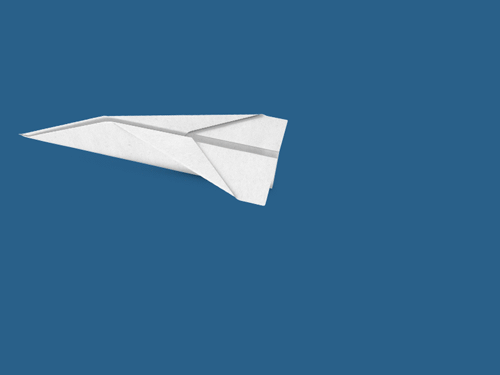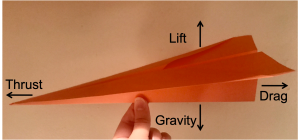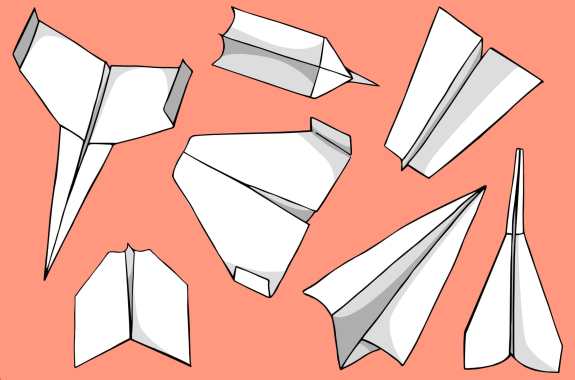Grade Level
All
minutes
15 min - 1 hr
subject
Engineering and Tech
stem practices
Developing and Using Models
Activity Type:
After School Activity, Family activity, Engineering activity
Unsure about a new design? Scientists and engineers often start with a model. With a model, you can test new ideas on a small-scale before going bigger. They are also cheaper, easier to produce, and often expose any design flaws.
For us at home, the paper airplane continues to serve as a popular model to explore physics, aerodynamics, and engineering. Discover what makes a paper airplane fly longer, farther, and higher with this design challenge—all you need is a piece of paper!

Gather Materials
- Recycled paper (try to get a bunch of different types)
- Tape
- Ruler
- Paper Airplane Data Collection Worksheet
Before we start building, we need to prepare to test all of our designs. Find a space in your home where paper airplanes can fly safely. Grab a ruler and use tape to mark every 12 inches along the floor. Use the Paper Airplane Data Collection Worksheet to record the distance of multiple airplane flights.
Build A Base Design
Using recycled materials from around your home, fold a “basic dart” paper airplane.
How far does your basic dart airplane fly? Do you have ideas for how to make your plane fly farther?
Test Out Some Variations
Like all planes, paper airplanes experience four forces: gravity, thrust, lift, and drag. Simple changes, like wing size, body weight, and throw power can significantly alter the forces your plane experiences.

Get creative and adjust various aspects of your plane. Here are a few ideas to get you started:
#1: Increase Lift
As the plane travels, air moves quickly over the top of the wings. This creates lower pressure over the wings, allowing the high pressure under the wings to lift the plane up. Try making wider wings or wings that curve up or down at the ends.
#2: Limit Drag
Air molecules push against the front of the plane as it travels, slowing it down. Make sure your plane’s nose is pointed and the body is lightweight.
#3: Change The Thrust
When you throw your plane, you provide thrust, which pushes the plan forward through the air. This forward movement causes air molecules to travel over the top and bottom of the wings. Does the strength or the angle at which you throw your plan have an impact?
#4: Try A New Material
The weight of the plane can pull it downward. How does a heavier or lighter paper change your plane?
Design Your Own Airplane
Put your design skills to the test with a paper airplane flight challenge! After creating so many test planes, you should have a good idea of what goes into making a paper plane that can travel long distances.
The Challenge
Gather members of your household and see who can produce the model plane that flies farthest. Remember to consider the forces your plane will experience when designing your plane.
Reflection Questions
1. Are there other ways to define paper airplane success besides distance?
2. What changes did you make to your original plane design?
3. How did members of your household design their planes differently?
4. What was most surprising to you about your plane tests?
What’s The Science?
All airplanes, whether in your house or 35,000 feet in the sky, fly because the forces that push and pull them are balanced. It may sound simple, but many important design choices contribute to successfully keeping a plane in the air.
Even though more than a century has passed since humans achieved powered flight, new plane designs are still emerging. Researchers are especially interested in ways to make planes more environmentally friendly. Over the years, NASA has developed and tested new plane technologies, including ways to reduce fuel consumption and noise pollution. Recently, Airbus revealed a new airplane design that promises to release zero emissions into the atmosphere.

Related Links
Excited to learn more about the aerodynamics behind paper planes? Start with some advice from the world record holder for longest paper airplane flight: Aerodynamics Explained by World Record Paper Airplane Designer
Looking to become an experienced airplane folder? Check out Fold N’ Fly for basic and expert-level tutorials.
Written by Jennifer Powers
Cover illustration by Carrie Lapolla
Editing by Xochitl Garcia and Ariel Zych
Digital Production by Ariel Zych
Meet the Writer
About Jennifer Powers
Jennifer Powers is a science educator at the Oregon Museum of Science and Industry in Portland, where she makes science fun for everyone through strategically designed exhibits and hands-on activities. She has bachelor’s degrees in botany and Spanish from Washington State University and a master’s degree in plant ecology from the University of Wyoming.

